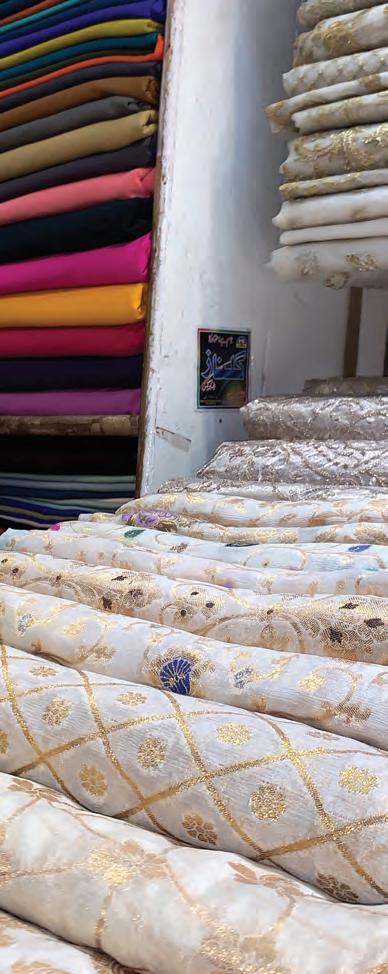
4 minute read
How to suit up — the right way
A guide to suit shopping and looking your best in a professional fit.
Written by Tyler Campbell | Photos courtesy of Adobe Stock
Advertisement
The right suit will help you to stand up to whatever is thrown your way during the daily grind. While you can order a suit online and adjust certain aspects at a later time, it can get fairly pricey. I'd recommend searching the net to get an idea of what you are looking for, and then going to a high-end retailer. Keep in mind that where you go depends on your budget. When going to a retailer, you can work with a professional to determine what colors and styles look best on you. If possible, bring an opinionated friend along for the ride. This way, you can avoid being sold on a lie. Regardless, picking the correct suit can be a time-consuming ordeal, so be sure not to be in a hurry. Here are a few tips to help you choose your fit.
Decide on a Color
Choosing the proper color depends on what you are buying the suit for. If you are an everyday suit wearer, then it solely depends on your preference. If this is the case, then you can be as creative as can be. If you are going to a wedding or funeral, then go black or navy. If you plan to wear it several times a week to work, then go for a dark color.
Things to Know
When purchasing a suit, there are a few things that you must be aware of before entering a store. This is especially true if you wish to shop online. You must be familiar with your sizes. Suits are not a one-size-fits-all type of clothing. If your suit doesn't fit you correctly, then your suit is wearing you. Let’s be real, this is not the way that you want to present yourself. An expensive suit will not make up for a sloppy fit. You will likely need to try on several suits before making a purchase, even when you know all of your sizes. Nonetheless, here are the specific areas that you should focus on; from top to bottom:

Shoulder Size
Adjusting the shoulders of a jacket after purchase is impractical and very expensive, so get it right from the beginning.
Chest Size
A good rule of thumb is if you can fit two fists in between your chest and the jacket, then it’s far too big. However, be sure it isn't too tight either.
Suit Jacket Length
The jacket should more or less cover your posterior.
Suit Jacket Sleeve
To test this, you should place your arms at your side. The sleeve should be around your wrist, with about a quarter to half an inch of room to show your shirt cuff. However, sleeve length is a relatively simple and inexpensive adjustment.

Waist Size
Again, your pants cannot fit too loosely or too tight. This can also be slightly adjusted, but aim to get it right. Pants Length: The pants need to be an appropriate length and should not fold above your shoes.
Material
In truth, there is enough material on materials to write an entirely separate article. However, for the purpose of this article, we will focus on the best quality material for a suit. In our case, wool is the best choice. If possible, you want to wrap yourself in 100 percent wool. You will likely come across several wool blends, which is less expensive but lower quality. You will also see super wools, that typically range from 80 to 160. This refers to the wool fiber. There are super wools that go up to 250, but they can get quite costly. Super 100 to 140 is a solid sweet spot. There are also different types of wool, such as Virgin, Worsted, and Merino. Honestly, it can get extensive, but Worsted is the most common.
Other Notable Features
Suit Buttons
There are jackets with buttons from one to five. Stick to two or three.
Suit Lapels
There are three types of lapels: Notch, Peak, and Shawl. I would recommend Notch, but Peak lapels have an elegant look to them. Shawls are for more formal gatherings.
Jacket Pockets
Some jacket pockets are sewn in, which is called a patch pocket. Others have a flap. Go with the flap, if possible.
Jacket Vents
These are the slits on the back of the jacket. They range from zero to two. Avoid the no vent jackets; they are too old school. Double vents are the classiest, but singles are the most common.
Picking the proper shoes, tie, shirt, and belt is another essential factor. However, I will trust you to take care of that part on your own. Suits are an integral part of every man's wardrobe. Hopefully, this guide should be a great starting point for making a purchase. Now, Suit Up!

Continued from page 9
Designing an outfit in Pakistan is an experience that is unforgettable. From choosing the fabric at the Rabi Centre to strutting along the bazaars in Sudder, I was able to customize the different laces, buttons, and embellishments to complete the outfit. Every inch of the traditional gown can be handpicked, which is what makes this experience one of a kind to many. During the wedding season, brides from abroad travel to Pakistan to design their bridal gowns from scratch. Every single detail, down to the color of thread that is used for the embroidery, is chosen by the bride for the fraction of the price. Every individual feature used to create a traditional ensemble has been handcrafted by local Pakistanis. This is one of the reasons I wear these clothes with pride. It was made by people who genuinely understand and care for every aspect of our unique culture.
After personalizing the outfit, another essential part of the attire is the jewelry. Pakistanis are known to showcase extravagant gold. Individuals head over to Tariq Road to select jhumkey (earrings), mala’s (necklaces), teeka (headpieces), and chooriyan (bangles). These four accessories complete the full Pakistani traditional look.

Karachi, Pakistan holds many phenomena, but the design district has definitely been one to capture the heart. Shopping in Karachi has been one of the most special experiences in my life because every single passing moment is meaningful and sentimental. Immersing yourself in your own culture can be difficult but when the culture is this lively and colorful, it makes it well worth it.




